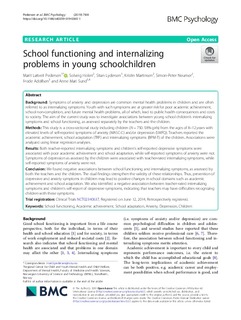| dc.contributor.author | Pedersen, Marit Løtveit | |
| dc.contributor.author | Holen, Solveig | |
| dc.contributor.author | Lydersen, Stian | |
| dc.contributor.author | Martinsen, Kristin Dagmar | |
| dc.contributor.author | Neumer, Simon-Peter | |
| dc.contributor.author | Adolfsen, Frode | |
| dc.contributor.author | Sund, Anne Mari | |
| dc.date.accessioned | 2020-01-13T10:22:32Z | |
| dc.date.available | 2020-01-13T10:22:32Z | |
| dc.date.created | 2020-01-06T11:01:32Z | |
| dc.date.issued | 2019 | |
| dc.identifier.issn | 2050-7283 | |
| dc.identifier.uri | http://hdl.handle.net/11250/2635913 | |
| dc.description.abstract | Background
Symptoms of anxiety and depression are common mental health problems in children and are often referred to as internalizing symptoms. Youth with such symptoms are at greater risk for poor academic achievement, school non-completion, and future mental health problems, all of which, lead to public health consequences and costs to society. The aim of the current study was to investigate associations between young school children’s internalizing symptoms and school functioning, as assessed separately by the teachers and the children.
Methods
This study is a cross-sectional study including children (N = 750. 58% girls) from the ages of 8–12 years with elevated levels of self-reported symptoms of anxiety (MASC-C) and/or depression (SMFQ). Teachers reported the academic achievement, school adaptation (TRF) and internalizing symptoms (BPM-T) of the children. Associations were analyzed using linear regression analyses.
Results
Both teacher-reported internalizing symptoms and children’s self-reported depressive symptoms were associated with poor academic achievement and school adaptation, while self-reported symptoms of anxiety were not. Symptoms of depression as assessed by the children were associated with teacher-rated internalizing symptoms, while self-reported symptoms of anxiety were not.
Conclusion
We found negative associations between school functioning and internalizing symptoms, as assessed by both the teachers and the children. The dual findings strengthen the validity of these relationships. Thus, prevention of depressive and anxiety symptoms in children may lead to positive changes in school domains such as academic achievement and school adaptation. We also identified a negative association between teacher-rated internalizing symptoms and children’s self-report of depressive symptoms, indicating that teachers may have difficulties recognizing children with these symptoms. | nb_NO |
| dc.language.iso | eng | nb_NO |
| dc.publisher | BMC (part of Springer Nature) | nb_NO |
| dc.rights | Navngivelse 4.0 Internasjonal | * |
| dc.rights.uri | http://creativecommons.org/licenses/by/4.0/deed.no | * |
| dc.title | School functioning and internalizing problems in young schoolchildren | nb_NO |
| dc.type | Journal article | nb_NO |
| dc.type | Peer reviewed | nb_NO |
| dc.description.version | publishedVersion | nb_NO |
| dc.source.volume | 7 | nb_NO |
| dc.source.journal | BMC Psychology | nb_NO |
| dc.source.issue | 88 | nb_NO |
| dc.identifier.doi | 10.1186/s40359-019-0365-1 | |
| dc.identifier.cristin | 1766655 | |
| dc.description.localcode | © The Author(s). 2019 Open Access This article is distributed under the terms of the Creative Commons Attribution 4.0 International License (http://creativecommons.org/licenses/by/4.0/) | nb_NO |
| cristin.unitcode | 194,65,35,5 | |
| cristin.unitname | RKBU Midt-Norge - Regionalt kunnskapssenter for barn og unge - psykisk helse og barnevern | |
| cristin.ispublished | true | |
| cristin.fulltext | original | |
| cristin.qualitycode | 1 | |

